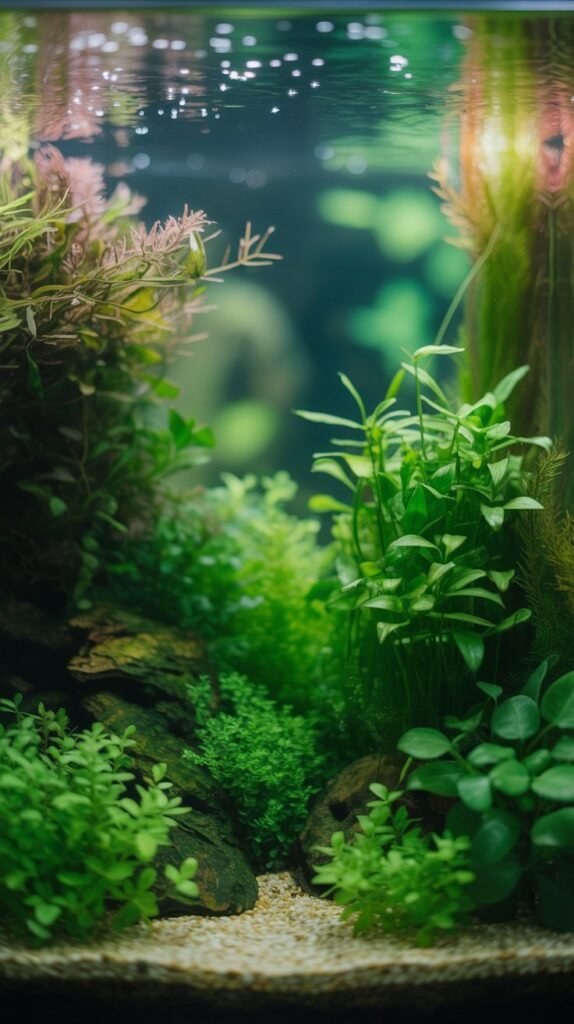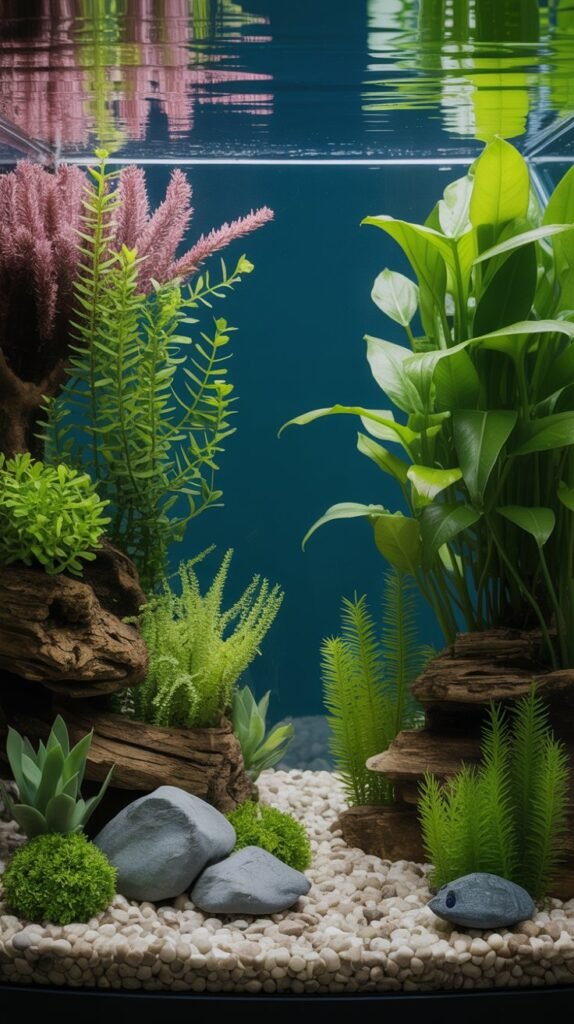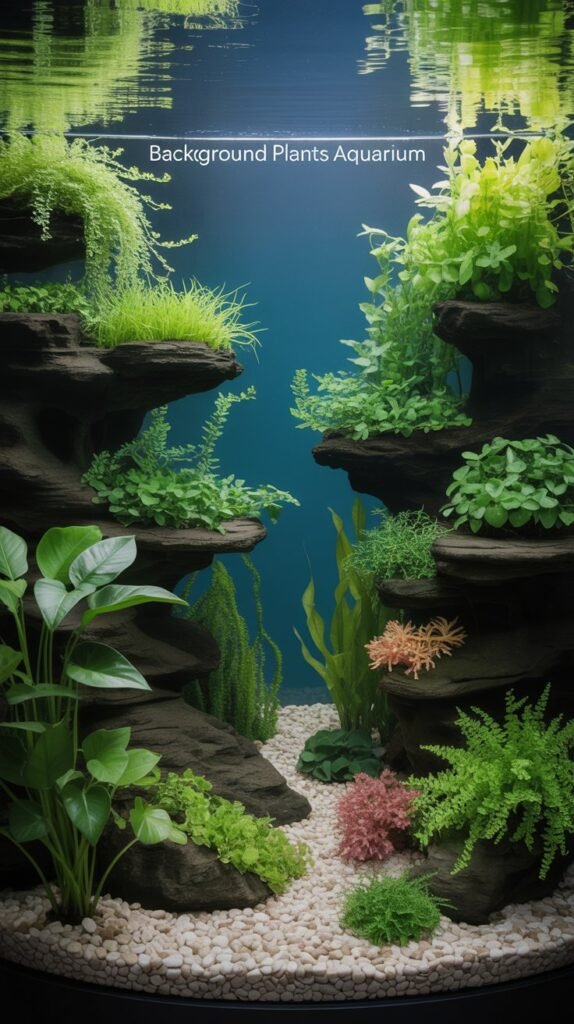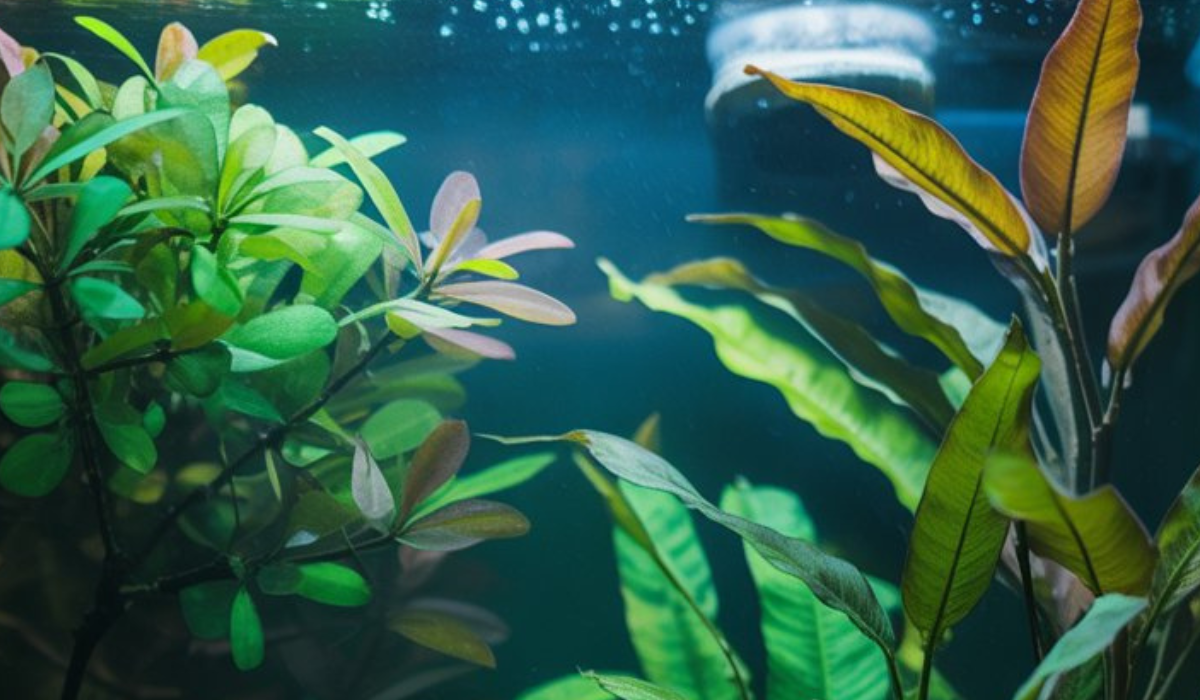An aquarium isn’t just a tank of water filled with fish — it’s a living piece of art. Every element, from lighting to substrate, contributes to its beauty and balance. Among these elements, aquarium plants play one of the most important roles in creating a natural and visually appealing underwater environment. While many aquarists focus on foreground plants or carpeting species, background plants are the real stars that complete the aquascape, adding height, depth, and visual harmony.
In this detailed guide, we’ll explore everything you need to know about background aquarium plants — from their benefits and types to the best species for your setup, along with planting tips, maintenance advice, and FAQs at the end.
What Are Background Aquarium Plants?
Background plants are tall-growing aquatic plants that are placed at the back of the aquarium to serve as a visual backdrop. They typically grow between 10 to 30 inches tall, depending on the species and tank conditions.
These plants create a natural wall of greenery that enhances the sense of depth and scale in your aquarium, hiding unsightly equipment like filters, heaters, and cables while giving the tank a polished, professional look.
In aquascaping, background plants are essential for framing the overall design — much like trees or tall shrubs in a garden. They complement foreground and midground plants, making your aquarium look balanced and three-dimensional.
Benefits of Background Plants in Aquariums

Background aquarium plants do more than just beautify your tank. They bring a range of functional and ecological benefits that improve your aquarium’s overall health and stability.
1. Enhance Visual Depth and Aesthetics
Tall plants at the back of the tank create a sense of perspective and depth, making your aquarium appear larger and more natural.
2. Provide Shelter and Security
Many fish species, especially shy ones, use tall background plants as hiding spots. This helps reduce stress and encourages natural behavior.
3. Improve Water Quality
Like all aquatic plants, background species absorb ammonia, nitrates, and other waste compounds, helping maintain a clean and healthy ecosystem.
4. Oxygenate the Water
Through photosynthesis, plants produce oxygen, which benefits fish and beneficial bacteria in your aquarium.
5. Reduce Algae Growth
By competing with algae for nutrients, background plants help suppress unwanted algae naturally.
6. Hide Equipment
Background plants effectively conceal filters, heaters, and tubing, maintaining a clean and natural look.
Factors to Consider When Choosing Background Aquarium Plants
Before adding any background plant, it’s important to assess your aquarium’s setup and compatibility. Here are key factors to consider:
1. Tank Size
Tall plants need enough vertical space. Larger tanks (30+ gallons) are ideal for robust species like Vallisneria or Amazon Sword.
2. Lighting
Most background plants need moderate to high lighting to grow tall and maintain healthy coloration.
3. CO₂ Requirement
Some species require CO₂ injection for optimal growth, while others thrive in low-tech tanks.
4. Substrate
Use nutrient-rich substrates like aquasoil or plant-specific gravel to promote root growth.
5. Water Conditions
Stable temperature, pH, and hardness levels ensure long-term health and consistent growth.
Types of Background Aquarium Plants

Background plants come in a variety of shapes, colors, and growth patterns. Here are the main types to choose from:
1. Stem Plants
These grow vertically from the substrate and can be trimmed easily. They are fast-growing and great for beginners.
Examples: Ludwigia, Hygrophila, Rotala, Bacopa.
2. Rosette Plants
They grow from a central crown and produce long leaves that extend upwards.
Examples: Amazon Sword, Cryptocoryne balansae.
3. Grass-like Plants
These have ribbon-like leaves that sway gently in the current, adding movement to your aquascape.
Examples: Vallisneria, Aponogeton, Giant Hairgrass.
4. Red or Colored Background Plants
Used for contrast and visual variety.
Examples: Alternanthera reineckii, Ludwigia repens, Rotala rotundifolia.
Top 10 Best Background Aquarium Plants
Let’s dive into the most popular and effective background plants for aquariums, loved by aquascapers and hobbyists alike.
1. Amazon Sword (Echinodorus bleheri)
Overview:
A classic choice for background planting, the Amazon Sword is large, hardy, and perfect for beginners. Its long, sword-shaped leaves create a natural jungle look.
Requirements:
- Light: Medium
- CO₂: Not required
- Temperature: 72–82°F
- pH: 6.5–7.5
- Height: Up to 20 inches
Tip: Use a nutrient-rich substrate to support its large root system.
2. Vallisneria spiralis (Italian Vallisneria)
Overview:
A fast-growing, grass-like plant that’s great for filling the back of your tank. Its ribbon-like leaves can grow several feet long.
Requirements:
- Light: Medium
- CO₂: Optional
- Temperature: 68–82°F
- pH: 6.0–8.0
Tip: Regular trimming helps control height and maintain shape.
3. Ludwigia repens
Overview:
This colorful stem plant features green and red leaves, adding a warm tone to your aquascape. It’s easy to grow and very versatile.
Requirements:
- Light: Medium to high
- CO₂: Recommended
- Temperature: 72–82°F
- pH: 6.0–7.5
Tip: Increase light intensity to bring out red pigmentation.
4. Hygrophila polysperma
Overview:
A hardy, fast-growing plant that can quickly fill your background area. Its vibrant green leaves make it perfect for beginners.
Requirements:
- Light: Low to medium
- CO₂: Optional
- Temperature: 68–82°F
- pH: 6.5–7.5
Tip: Trim regularly to prevent overshadowing smaller plants.
5. Rotala rotundifolia
Overview:
This elegant stem plant displays green leaves that turn pink or red under high light. It’s a favorite among aquascapers for contrast and layering.
Requirements:
- Light: High
- CO₂: Essential for color enhancement
- Temperature: 70–82°F
- pH: 6.0–7.5
Tip: Keep multiple stems close for dense, bushy growth.
6. Bacopa caroliniana
Overview:
Known for its thick, oval leaves, Bacopa caroliniana grows steadily and adds structure to the back of your tank.
Requirements:
- Light: Medium
- CO₂: Recommended but not necessary
- Temperature: 68–82°F
- pH: 6.0–8.0
Tip: Easy to propagate by trimming and replanting stem cuttings.
7. Cabomba caroliniana
Overview:
A soft, feathery plant that creates a dense green backdrop. It provides excellent cover for small fish and shrimp.
Requirements:
- Light: High
- CO₂: Beneficial
- Temperature: 70–82°F
- pH: 6.0–7.5
Tip: Avoid strong water currents as it can uproot easily.
8. Aponogeton crispus
Overview:
Known for its unique wavy leaves, this plant adds texture and movement to any aquarium.
Requirements:
- Light: Medium
- CO₂: Optional
- Temperature: 72–82°F
- pH: 6.0–7.5
Tip: Give it space — leaves can grow up to 20 inches long.
9. Cryptocoryne balansae
Overview:
With long, crinkled leaves and slow growth, this plant provides a lush, textured background ideal for low-tech aquariums.
Requirements:
- Light: Low to medium
- CO₂: Not required
- Temperature: 72–82°F
- pH: 6.0–7.5
Tip: Don’t move it often; it dislikes changes and may “melt.
10. Alternanthera reineckii (Scarlet Temple)
Overview:
One of the most vibrant background plants with red and purple hues, perfect for adding color contrast to green aquascapes.
Requirements:
- Light: High
- CO₂: Essential for bright coloration
- Temperature: 72–82°F
- pH: 6.0–7.0
Tip: Trim regularly to maintain bushy, vibrant growth.
Planting and Maintenance Tips for Background Aquarium Plants

Growing healthy and beautiful background plants requires some care and technique. Here’s how to get the best results:
1. Plant in Rows or Groups
Planting background species in groups of 3–5 stems creates a natural, forest-like effect.
2. Use Proper Tools
Use aquascaping tweezers to insert plants deep into the substrate without damaging roots.
3. Provide Consistent Lighting
Ensure 8–10 hours of consistent lighting daily. Use LED aquarium lights with a balanced spectrum for plant growth.
4. Add Fertilizers
Root-feeding plants like Amazon Swords benefit from root tabs, while stem plants thrive with liquid fertilizers.
5. Regular Trimming
Trimming prevents plants from shading lower layers and encourages bushier growth.
6. Maintain Stable Water Parameters
Avoid sudden temperature or pH changes. Most background plants thrive in stable, moderate conditions.
Aquascaping Ideas Using Background Plants
Here are a few aquascaping styles that highlight the importance of background plants:
1. Nature Style Aquascape
Inspired by natural landscapes, this style combines tall background plants like Vallisneria with midground plants like Java Fern for a lush forest look.
🪨 2. Iwagumi Style
This minimalist Japanese design focuses on rocks as the centerpiece. A light background with stem plants s
uch as Rotala or Ludwigia adds contrast.
3. Dutch Aquascape
A garden-like style that emphasizes colorful plant arrangements. Background plants like Alternanthera and Bacopa create vibrant backdrops.
4. Jungle Style
Dense planting using tall species such as Amazon Swords and Cryptocorynes to create a wild, overgrown look — perfect for natural aesthetics.
Best Tank Mates for Background Aquarium Plants
Choosing compatible tank mates is important to prevent damage to your plants. Ideal companions include:
- Tetras (Neon, Ember, Cardinal)
- Guppies and Mollies
- Shrimp (Amano, Cherry)
- Otocinclus Catfish
- Snails (Nerite, Mystery)
Avoid species that uproot or eat plants, such as Goldfish, Plecos, or large Cichlids.
Common Problems and Their Solutions
| Problem | Cause | Solution |
|---|---|---|
| Leaves turning yellow | Nutrient deficiency | Add root tabs or liquid fertilizer |
| Stunted growth | Low light or CO₂ | Increase light intensity or add CO₂ |
| Melting or disintegration | Sudden parameter changes | Maintain stable water chemistry |
| Algae overgrowth | Excess light or nutrients | Reduce light duration and dose fertilizers carefully |
| Uprooting | Strong water current or fish | Anchor plants firmly using plant weights |
Background Plants for Low-Tech Aquariums
If you prefer a low-maintenance setup without CO₂ injection or high lighting, here are ideal background plants:
- Amazon Sword
- Cryptocoryne balansae
- Vallisneria spiralis
- Hygrophila polysperma
- Bacopa caroliniana
These species are hardy and thrive in moderate conditions with minimal care.
Final Thoughts
Background plants are the backbone of any successful aquascape. They add structure, depth, and balance, transforming a simple fish tank into a natural aquatic paradise. By choosing the right species and maintaining proper conditions, you can create a stunning underwater world that’s both healthy and visually captivating.
Whether you prefer a minimalist Iwagumi design or a lush, jungle-style aquascape, background aquarium plants play a critical role in achieving that dream look. With patience, regular care, and the right setup, your aquarium will become a living masterpiece that both you and your fish will enjoy.
FAQs About Background Plants Aquarium
Q1: Do background plants need CO₂?
A: Not all of them. Fast-growing and colorful species like Rotala and Alternanthera benefit from CO₂, while hardy options like Vallisneria and Amazon Swords grow fine without it.
Q2: How tall do background plants grow?
A: Most background plants range between 10–30 inches in height, depending on species and tank conditions.
Q3: Can background plants grow in gravel?
A: Yes, but adding root tabs or nutrient supplements will improve their growth and health.
Q4: How often should I trim background plants?
A: Trim every 2–3 weeks to maintain shape and prevent shading of foreground plants.
Q5: What lighting is best for background aquarium plants?
A: Moderate to high lighting (8–10 hours daily) promotes healthy and vibrant growth.
Q6: Can I mix red and green background plants?
A: Absolutely! Mixing colors like Ludwigia repens (red) and Bacopa (green) adds visual contrast and depth.
Q7: What’s the best substrate for background plants?
A: Nutrient-rich substrates such as aquasoil or planted tank gravel are best for root-feeding species.
Q8: Which background plants are beginner-friendly?
A: Amazon Sword, Vallisneria, and Hygrophila polysperma are great for beginners due to their hardiness.
Q9: Why are my background plants melting?
A: It’s often due to acclimation stress when introduced to new water parameters. Give them time — new growth will soon replace melted leaves.
Q10: Can background plants improve water quality?
A: Yes! They absorb nitrates and toxins, oxygenate the water, and help keep algae under control.

